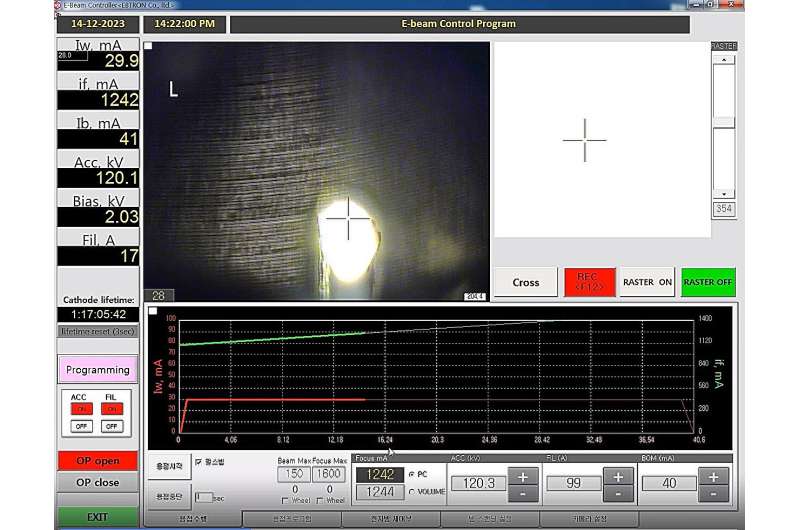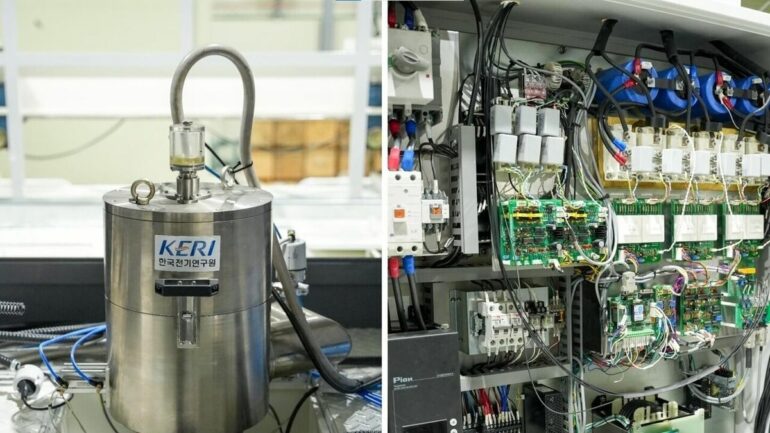Dr. Han Seong-Tae’s team at KERI’s Industry Applications Research Division has developed the core technology of “electron guns,” the heart of “electron beam welders,” which had been dependent on imports for more than 99%.
“Welding,” which can be said to be the basis of industry, is the process of melting and joining various materials such as metal. Traditional welding utilizes heat from an arc (a spark generated by an electrical discharge) or a laser. Electron beam welders, on the other hand, use the kinetic energy of electrons to bond materials together.
In other words, when an electron beam is radiated, electrons accelerated to a high voltage collide with the welded material and the kinetic energy is converted into heat energy. The welded items are joined to each other by the high heat generated at this time.
The advantage of electron beam welding is that it enables defect-free joining of thick materials that could not be achieved with conventional welding. Recently, in the era of the 4th Industrial Revolution, the production of cutting-edge devices is required in various fields.
In particular, a higher level electron beam welder is becoming necessary for special purposes such as aerospace, defense, and nuclear power. The combustor of the Nuri launch vehicle, launched in 2021, also utilized an electron beam welder to flawlessly attach specialty steel materials and components.
Electron beam welding requires very high technical skills, and Korea has been relying on imports of more than 99% of related equipment from Germany and Japan. In consequence, there is a risk of leakage of domestic advanced technology in the process of maintaining and repairing imported welding machines.
Seong-Tae’s team’s achievement in solving this problem was to achieve local production of electron guns and driving power systems, which are the core of electron beam welders.

Welding operation screen using the electron beam welder. © Korea Electrotechnology Research Institute(KERI)
With electron beam welders, the higher the acceleration energy of the electron guns, the greater the extent to which they can penetrate the heat source into the material. KERI’s technology boasts world-class power (60 kW) and accelerated voltage (120 kV).
This is a level that can be utilized for machining almost any thick, large material and part. The research team put a lot of effort into optimizing electric and magnetic field structures and minimizing voltage imbalance based on high-voltage technology accumulated over more than 20 years to develop high-performance equipment, and the efforts bore remarkable results.
This achievement has opened the way for Korea to use electron beam welding without dependence on foreign countries. As most of the 12 national strategic technologies that will lead the future require electron beam welding, it is expected to have a significant impact in terms of the development of related industries, effect of replacing imported equipment and prevention of technology leaks.
Seong-Tae said, “As the industry moves to high value-added areas, the demand for high-precision and quality welding will increase, and there will be more products that cannot be manufactured without electron beam welding.” He also added, “It is also significant in that it opens up a new avenue for domestic production of customized, high-tech source equipment that only high-performance electron beam welders can provide.”
KERI, which has applied for patents and published overseas papers related to the technology, plans to develop ultra-high (170 kV or more) and high current (500 mA or more) electron guns that can be applied to next-generation small modular reactors (SMRs) through continued research.
KERI also aims to have control technology that can perform multiple functions, including metal melting, material hardening, surface treatment, and coating, to enable electron beam welding to be utilized in a wider range of applications, including 3D printing of complex metal structures that require high strength.
The findings are published in the journal IEEE Transactions on Plasma Science.
More information:
Seong-Ho Son et al, Development of 120 kV and 60 kW Three Phase LCC Resonant Converter for Electron Beam Welding System, IEEE Transactions on Plasma Science (2023). DOI: 10.1109/TPS.2023.3288116
Provided by
National Research Council of Science and Technology
Citation:
Korean researchers achieve local production of electron beam welding system (2024, March 5)



